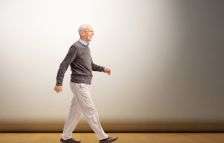Falls assessment in older Aussies takes a step forward

Fall risk assessment in older adults has taken a step forward thanks to a new measure that can more accurately assess underlying physical and neurocognitive disturbances that may predict future falls
Over a third of older adults (70 years and over) experience a fall each year, with more than half falling multiple times. Predicting who is likely to experience a fall is an effective way to identify who will benefit from fall prevention programs such as step training.
The study, a collaboration between researchers from Neuroscience Research Australia (NeuRA), UNSW and the University of Leeds, found that high intraindividual variability (IIV) in stepping tasks could indicate reduced efficacy of the brain circuits required for executive functioning, walking gait and postural control in persons with mild cognitive impairment (MCI), which increases their likelihood of suffering a fall.
Intraindividual variability refers to the differences in reaction times an individual may display across several test trials. It is thought to offer predictive information about cognitive functions, such as attention and executive control, which are associated with age-related decline or mild cognitive impairment.
The study assessed 425 individuals aged between 70 and 90 as they completed tasks using their hands (simple and choice hand reaction time tasks) and, in a separate task, their feet (choice stepping time reaction task). Reaction times of each individual were compared across the trials, with higher variability in the stepping tasks indicating an increased risk of falls. This was particularly true in individuals with gait or posture impairments.
The study suggests that executive functions – such as attention – and postural control while walking share common frontal brain circuitry that is vulnerable to degeneration in older age, which could explain how IIV measures are able to capture compromised neural circuitry in MCI.
The findings of the study suggest that IIV measures can provide useful insights for clinicians to identify possible neurobiological disturbances such as MCI that could lead to an increased falls risk. "Measuring IIV is fast, accurate and requires very little neuropsychological training, so it is appropriate for many clinicians to use," says Dr Kim Delbaere from NeuRA.
"There is a need to prolong independence and quality of life in community-dwelling older adults living with mild cognitive impairment. As such is it important for us to better understand what causes falls in this group and how we can identify those who are likely to benefit most from programs that help to reduce falls."
This study will appear in a special falls-related issue of Journals of Gerontology: Medical Sciences.
More information: David Bunce et al. Intraindividual Stepping Reaction Time Variability Predicts Falls in Older Adults With Mild Cognitive Impairment, The Journals of Gerontology Series A: Biological Sciences and Medical Sciences (2016). DOI: 10.1093/gerona/glw164















